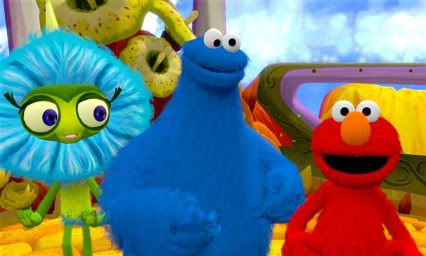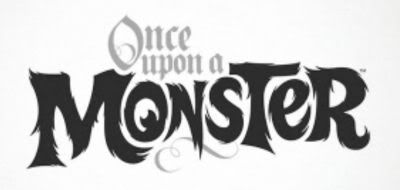- Format: 360 (Kinect required)
- Unleashed: Out Now
- Publisher: Warner Bros. Interactive
- Developer: Double Fine
- Players: 1-2
- Site: http://www.onceuponamonstergame.com/
Licensed games are often hastily cobbled together cash cows; licensed games aimed at children doubly so. Can Double Fine do justice not only to the world-famous Sesame Street license, but – most importantly of all – to the children who will play the game?
It’s important to realise that this is a Sesame Street game first, and a Double Fine game second. The multi-layered script of Psychonauts and determinedly unique art design of Stacking are worlds away, as everything must necessarily slot into the world of Sesame Street smoothly. In this respect, the game is a resounding success. It all looks and sounds wonderful, including authentic voices for Elmo and Cookie Monster who accompany you throughout the game. The monsters unique to Once Upon A Monster (created by Double Fine themselves) fit in very well with existing designs, though speak only in monster gibberish. Cameos from Grover and Oscar are more than welcome; though more Sesame Street regulars would have been more welcome still.
It’s clear that the entire game has been carefully planned with the young ages of the target audience in mind from start to finish, and the final product benefits hugely from this. There are no traditional menus to navigate. This is in essence a minigame collection, split into six different stories (the cutscenes for which are skippable). Each story and game is held within a single storybook, and youngsters turn from page to page by reaching out and turning these pages by hand. When they’ve arrived at the page they want, they reach one hand out to either side of the book and pull them apart to start that section. The motion recognition here is generous enough to ensure all this is easy for kids to do.
 There is no on-screen text to be read. Every game is explained by Elmo and/or Cookie giving very brief yet clear instructions, and gentle reminders are given if players seem to be struggling. Most games are variations on a theme; primarily throwing something into the screen, dressing a monster up, a travelling section where you steer by leaning left and right, using one hand as an aiming reticule, using your hands to ruffle an on-screen monster, and a Kinect favourite… dancing.
There is no on-screen text to be read. Every game is explained by Elmo and/or Cookie giving very brief yet clear instructions, and gentle reminders are given if players seem to be struggling. Most games are variations on a theme; primarily throwing something into the screen, dressing a monster up, a travelling section where you steer by leaning left and right, using one hand as an aiming reticule, using your hands to ruffle an on-screen monster, and a Kinect favourite… dancing.
That may sound dull and generic, but there are a few less used types; and, vitally, the context given to each game means that repetition doesn’t set in, and the experience remains fun and fresh for the kids throughout. Kids will love racing down a snowy mountain with Cookie Monster, dancing with Grover, running to keep up with another monster, flapping their arms to fly up a tree, feeding biscuits to adorable little creatures…
Although it’s Kinect that makes this simple and intuitive experience possible for youngsters, it’s this same technology that on rare occasions throws up problems. 99% of the time, the game does a fantastic job of recognising motions and poses. When it does struggle to recognise exactly what the player is doing however, this can quickly stretch the notoriously short attention spans of young kids to breaking point. Adults may soon realise that Kinect needs the arms to be a little further from the rest of the body, or that a certain action needs to be more exaggerated. Young children however, not unreasonably, tend to believe that doing what they’re asked to by the game is enough. When it isn’t, this leads to frustration and a play session cut short.
 This can be countered, to an extent, by playing the way it is primarily intended to be played; with a parent/guardian. So long as one of you succeeds, that’s enough to progress. In another display of understanding the needs of the younger player, co-op play is drop in/out to perfection. If a child becomes frustrated/distracted in the middle of a game and wanders off, the game continues seamlessly with the remaining player. If the child returns, they need only give a brief wave at the TV to join in once again. No pauses (unless Kinect detects no players at all) and no penalties. Best of all, dancing or waving around like a loon beside a smiling or laughing son/daughter/sibling/whatever while Elmo and Cookie Monster encourage them on-screen is an experience not to be missed.
This can be countered, to an extent, by playing the way it is primarily intended to be played; with a parent/guardian. So long as one of you succeeds, that’s enough to progress. In another display of understanding the needs of the younger player, co-op play is drop in/out to perfection. If a child becomes frustrated/distracted in the middle of a game and wanders off, the game continues seamlessly with the remaining player. If the child returns, they need only give a brief wave at the TV to join in once again. No pauses (unless Kinect detects no players at all) and no penalties. Best of all, dancing or waving around like a loon beside a smiling or laughing son/daughter/sibling/whatever while Elmo and Cookie Monster encourage them on-screen is an experience not to be missed.
You can go back to any previously completed game at any time, giving you complete control over which you play and in what order. It’s a good way to replay their favourites (one of which is likely to be the finale, where kids can narrate their own version of a story) or perhaps avoid those they struggle with. Expect this to be a game they play little and often.
Stars are earned as you progress, the rewards for which were – we presume – chosen with adults in mind. After all, will your kids really spend hours admiring concept art and developer interviews? Earning the maximum five stars for each game, and playing through the storybook multiple times, are rewarded with achievements which will slow down achievement hunters more than they anticipated. You know who you are.
It carries the occasional recognition problems all Kinect titles suffer from, but less than most. Your kids will love watching what’s going on on-screen (which may lead to you playing solo now and again!) just as much as they’ll enjoy joining in with it. You’ll enjoy playing alongside your kids having so much fun and, you never know, you might enjoy actually playing the games. Because you know what? So far as family Kinect titles go, even from an adult perspective, this is actually pretty fun.



















Comments